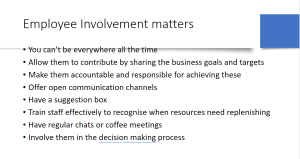Determine resource requirements
for new business ventures
About the Unit
This unit teaches you how to establish what resources your business needs, how to source and implement them into your new business venture.
Start with the Study guide BSBESB304
How do I calculate my start up costs?
Learning Outcomes
BSBESB304- Determine Resource requirements for new business ventures.
- Establish resource requirements for new business
- Source required resources
- Prepare for use of selected resources in the new business venture

Click on tabs below for Learning Content
What is a Resource?
There are 3 types of resources in business
- Human
- Physical
- Financial
Resources are anything used to produce something in your business. You may need Human resources such as knowledge and skills to produce your service or products.
Physical resources are raw materials, business premises, machinery, equipment, technology that may be required to produce goods and services.
Money is definitely a resource required to produce your goods and keep your business running.
Resources need to be managed like all parts of the business. The main goal when managing resources is to get the maximum output from the minimum input. You need to control your costs to produce maximum output.
Staffing is a good example of this. If you analyse your business and determine your busy periods and quiet periods. You will use your rostering of hours to make sure you have more people on your busier times than quieter times.
Secondly- you want this resource to be productive. This is achieved by training your staff well, giving them the tools they need to perform at their best, and setting clear performance goals to show how effective they are. Failure to do this could lead to lost revenue, lost customer satisfaction and lost business. You have wasted both your human resources and financial resources if you fail to introduce, maintain and measure their performance.
Meet Tom
He has his own gardening business.
His services include lawnmowing and garden clean ups.
Let’s look at the Resources he may require for his business.
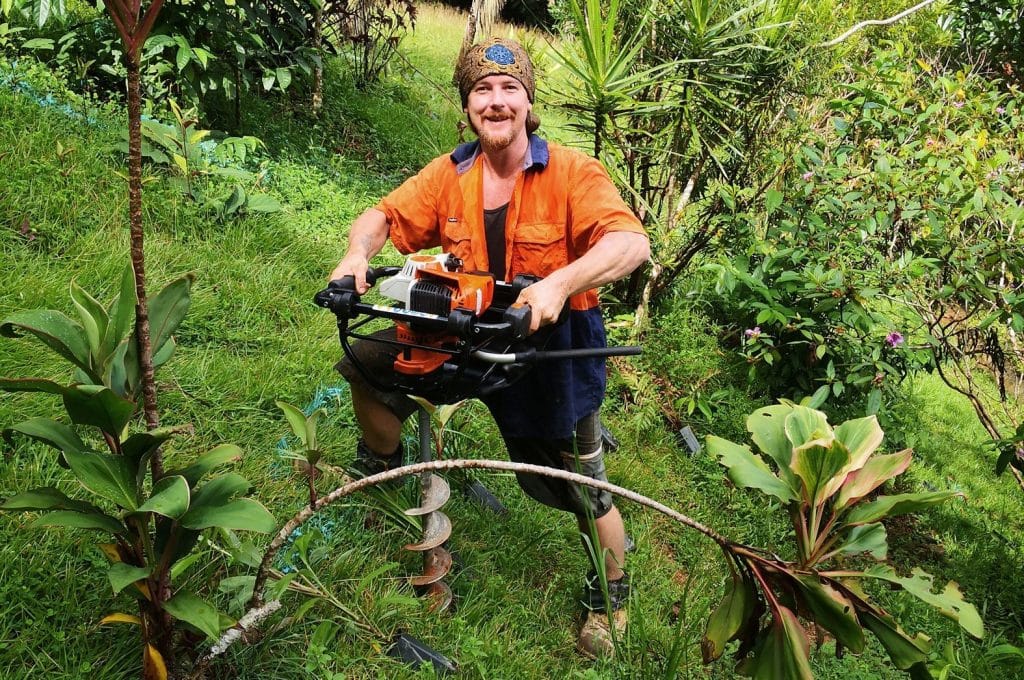
1. Human Resources
-He needs skilled, knowledgeable workers to provide services to his customers, who can work independently and in a team. They need to be fit and strong, flexible with excellent communication skills.
-He requires knowledge on how to quote, invoice, and collect money from customers. Also needs to understand what his tax and legal obligations are and how to promote and grow his business. (this could mean he outsources or learns these skills himself)
2. Physical Resources:
-Lawn mower, whipper snipper, hedge trimmers, tools.
-Vehicle and trailer for transporting equipment.
-PPE gear
-Chemicals for weed control
-Could decide on a computer and digital accounting software to help with accounts and marketing.
3. Financial Resources:
-Cash for operational costs like fuel, hiring equipment, paying wages, insurance, tip fees. Purchasing equipment to perform tasks required.
-Credit Card or Overdraft to help in emergencies.
Legislation and regulations when resourcing your business
Is Tom a Contractor or an Employee?
Independent contractors – Fair Work Ombudsman
Click on the picture below.
Is Tom a Contractor or Employee?
Tom provides his own tools and equipment, he co-ordinates when he is available to work, he pays for insurance and is responsible for the quality of the work and liable for any injuries that may occur.
Human Resources:
Fairwork Australia
- What are the rules and regulations for hiring staff?
- What is the difference between a contractor and an employee?
- What are the taxation responsibilities?
- When and how much do you need to pay?
- What are Tom’s Workplace Health and Safety Responsibilities to any staff he may hire?
He is a Contractor
Any person who works with Tom where he co-ordinates where, when and how they work are considered employees. They can be casual, part-time or full time and he is responsible for ensuring they follow safe work practices.
If he was to hire an arborist to cut down a tree, who provides his tools and has his own insurance. Then he is a contractor.
Physical Resources legislation and regulations
- Are the chemicals and equipment Tom uses legal and fit for purpose?
- Do they meet Australian safety standards?
- What licenses or registrations are required for his business?
- Does he have a lease for his premises? Is the contract legally binding?
- Under WHS Act what equipment and training must he provide?
Use the links for further information:
Understand your chosen business structure and how it effects resources.
Sole Traders – you are personally liable for all expenses incurred on the business. You may not have access to as many funds to grow the business. You get to make all of the decisions.
Partnerships- you and your partner(s) are liable for the debts of your business. You may have more access to funds. You may have trouble convincing other partners to invest in resources.
Company- Is managed by Directors and shareholders are not liable but will be affected by share prices. More people to make decisions about the business.
Trusts – are run for beneficiaries.
➡Review Knowledge Question 1 & 4
The Business Profile should include:
- Who you are -include your business name, logo and contact details.
- Business structure (sole trader, partnership, trust).
- Licenses and Registrations.
- What your business offers- what problem are you solving?
- Who is your target market?
- What are your business goals or objectives?
- What is the size or scale of your business including the projected sales and gross margins.
- Details about team roles or partnerships.
- Any business operation methods that the audience would be interested in.
➡Review Knowledge Questions 2 ,3,4 & 5.
& Task 1a Assessment 2
Creating a Business Profile
To establish resource requirements for your start-up, you need to understand what your business offers.
A Business profile is a written document which is a brief description offering a professional representation of the business structure and operation. It can be a useful exercise if you need to attract investors, gain financial support or other stakeholder interest. It can also be used to launch or promote your business.It is similar to your Executive Summary you completed at the beginning of your business plan.
The information provided will depend on the audience and what outcome you are wanting to achieve. Generally, confidential information and every day operational information is not included.
Complete your elevator pitch
Fill in the gaps below to describe your business in one sentence.
I help (insert who you help) to (functional outcome, financial outcome, emotional outcome) to (how does your business solve their problems?)
“I help entrepreneurs grow their business by improving their knowledge, saving them the confusion and stress of working it out on their own”.
Resource Management
These are the steps to follow when determining your resource requirements for your new business.
- Identify or list your resource requirements
- Research and Evaluate the Resources
- Source the resources
- Prepare Procedures to maintain and use resources
Procurement
Procurement is about sourcing your products, negotiating quality and price, delivery schedules and building relationships with your suppliers. It is about aligning your costs with your business plan.
- A procurement strategy can result in 3.8 times higher return on investment!
This 12 minute video explains how to get it right.
Identify or list resource requirements for your business
When identifying your resource requirements, you might research a number of different aspects. You may use your previous experience and knowledge to identify what it is you need for your business to operate. If you don’t have any experience, you may research your competitors, gain specialist advice, conduct online research or speak to industry specialists.
You identified some of your initial set up requirements in your “Establishment Costs” in your Financial Plan.
Refer to your Establishment Costs. What resources (property, plant and equipment) do you need for your business to operate?
How to Plan your resources
Step 1- Identify what resources you need now and also list ones you may need in the future.
Step 2- Put an estimate on the time each resource needs and what you need it for.
Step 3- Double check you haven’t missed anything.
Step 4- What is the quantity and quality you require?(refer to slide below on how to determine this)
Step 5- Determine your budget.
Step 6- Prioritise your list, starting with what you NEED now.
Step 7- Gain advice from a specialist (accountant) about tax advantages and acquisition options.
Step 8- Put an action plan in place aligned with your budget to acquire resources. (refer to Financial reports Assets, Establishment Costs and Profit & Loss)
Quantity- what factors may affect the quantity of resources needed?
When starting a business it is difficult to gauge quantities required. You have no history of sales to calculate from. You will need to use your experience, previous knowledge and advice from those you trust to establish what you need.
Your Business profile will give your company a good sales pitch and provide you with feedback from potential customers or stakeholders. Positive responses will encourage you to increase quantities in preparation for your success. Alternatively, the feedback may cause you to change your strategy and order different quantities or less.
Your market research will indicate the demand for your product or service. Regular monitoring of sales and performance will also indicate changes in demand. If demand is positive, then quantities required will increase. If demand drops, then quantities ordered will drop and possibly change altogether.
Your Business financial position will affect how much you can afford to buy. It may affect how you acquire the resource. You may need to hire it instead of purchase it. You do not want your cash tied up in stock. Stock is dead money. Regular monitoring of your cashflow situation will help you understand the quantities you can buy and when the best time to purchase them is.
Your financial plan is crucial to controlling your costs. It should be referred to when making resource acquisition decisions.
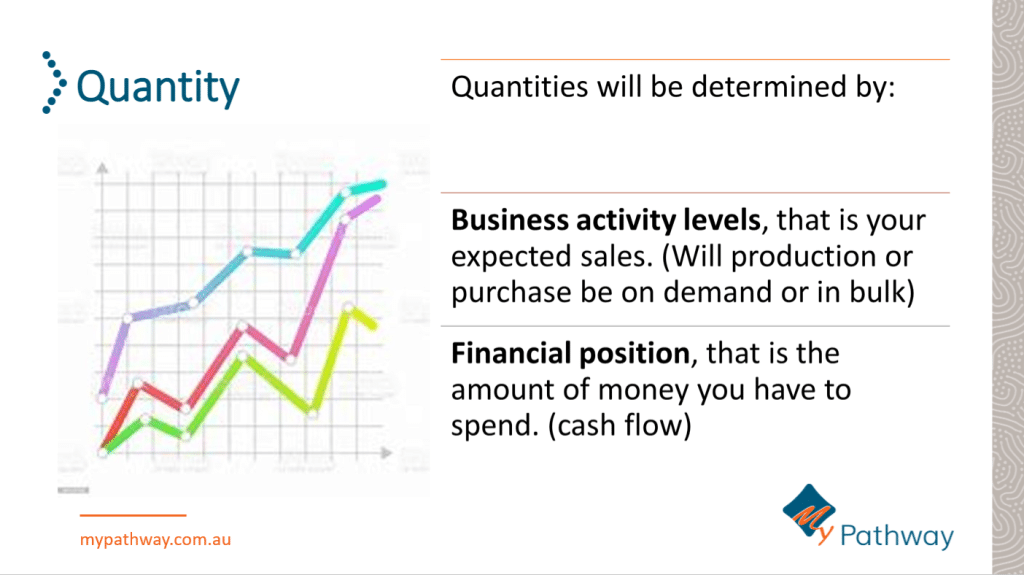
➡ Review Assessment 2- Task 1b and 1c
Identify your resource requirements:
There are different categories of resources you may require for your business to operate.
The example used is a fruit producer.
- Machinery needed is a tractor.
- Technology could be the drone, computer, phone.
- Consumables are goods that you use to support your product. Examples are the packaging, boxes, cling wrap and gloves.
- Equipment could be trolleys and office equipment
- Facilities and Capital- the shop
Property, Plant & Equipment (PP&E) are long term assets vital to business operations.
Sourcing, Assessing and Costing goods.
Once you have established the needs of your business, checked your financials and prioritised your needs, it is time to source your products or services you require.
The more you research and negotiate, the better deal you will get.
Your goal is to find the best quality, most reliable delivery and supply for the best price from a reputable source.
Cost Control is the practice of identifying and reducing business expenses to increase profits.
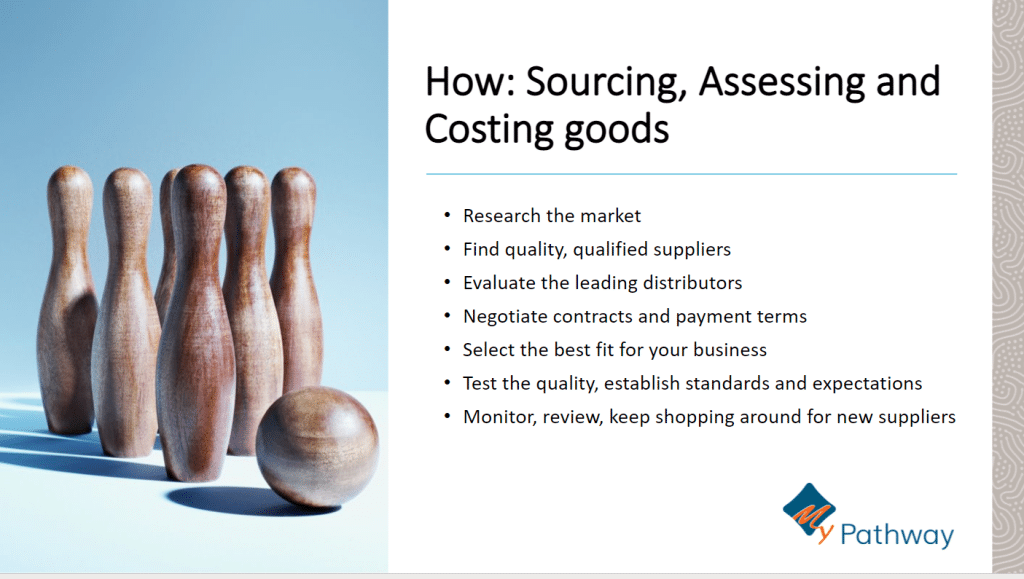
Researching & Evaluating Acquisition options.
When evaluating the best options for acquiring your identified resources, you need to conduct extensive research. You may need to ask similar businesses or your accountant for advice. You might conduct research on the internet or ring around and speak to suppliers. Whatever your method, your aim is to get the best quality, for the best price and consider the other factors such as:
- Reliability – Can they deliver on time, safely and securely.
- Quality – Is their quality consistent and of a high standard?
- Quantity- Can they provide small orders as well as large orders? How quick is their turnaround?
- Ease of access – is your supplier easy to contact, do they offer support and other services beneficial to your business outcomes
The 7R’s of Procurement video explains this more:
Risks to the business
When sourcing resources one risk mentioned above is reliability. Consider what would happen if suddenly supply slowed down due to increased demand, or your supplier goes under and you can’t get supply? What would the risk be to your business?
If you can’t keep up with demand for your product, sales will drop, customer satisfaction could drop, you may find your customers move to a competitor and you lose your hard earned reputation.
To prevent this from happening, you need a contingency plan.
- Research more than one supplier.
- Have a back up supplier ready in case this happens.
- Learn to produce the product yourself and skip the middleman.
- Network with other similar businesses, maybe they have spare stock they can share and vice versa.
- Consult specialists in the field for recommendations and inside knowledge.
Do not leave yourself open to the monopoly of only one supplier. Competition is good and keeps prices down,but remember to check the quality.
Also consider the other risks such as poor quality, price increases, illegal terms and conditions, unethical sources, long delivery times or no delivery at all. How would these affect your sales and business reputation?
➡Review Assessment 2- Task 2
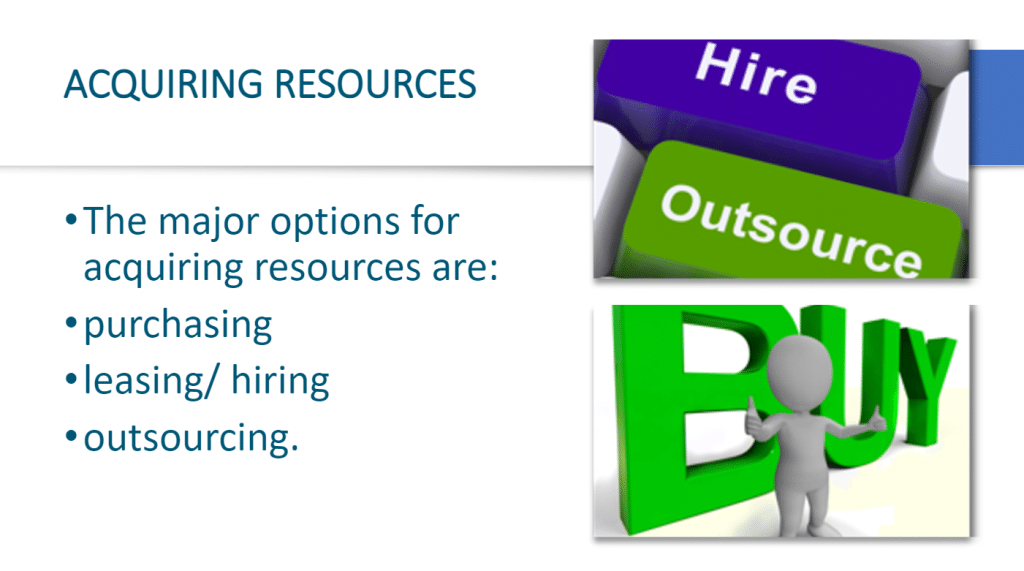
Click on these links below to explore these options further:
Procurement
Involves:
- managing the process
- managing the risk
- adding value
Refer to Procurement video on the previous page
How to implement the Procurement Process
Having a strong procurement process will prevent careless spending, secure the most competitive rates, maintain compliance and ensures you pay the correct price for what you receive.
The procurement process differs from business to business, however, a clear process needs to be implemented and could include some of the following steps.
Refer to video on previous page
➡Review Assessment 2- Task 4
Function versus Benefit
When making decisions on what resources you require it is vital to determine what is the function of the resource and what is its benefit to your business.
One example could be staff.
The staff function would be the job description that you need them for. You might identify that you need a staff member to run your Marketing.
Their function is to be responsible for marketing your business, posting social media, conducting market research and presenting you every month with the results of their KPI’s.
The benefits of having this Marketing person are that your sales and brand awareness increase. Your time management and productiveness improves because you can now focus on the other parts of your business.
The function is what the resource does, and the benefit is what positive outcomes it produces.
Challenges when resourcing
We often face challenges when sourcing our resources.
- Do we have the finances?
- Do we have the technical know-how?
- Do we have the time?
- Is there the correct quantity or quality available?
- How much will we need?
- What is the market and economy doing?
- What is the demand going to be?
All business decisions need to be considered carefully. Conducting a Cost- Benefit analysis or a Return-on-Investment analysis will assist you in the decision-making process.
Consulting a specialist such as your accountant will also help you weigh up your options and ensure it is in the businesses best interests to invest.
Failure to regularly consult your Financial and Business Plan could lead to some poor business decisions about resource planning, which will cost you in the long run.
Warranties & Conditions of use
Did you know that “Conditions are a set stipulation of the contract but warranties are considered an additional set of rules?” (www.upcounsel.com/warranty-and-condition-in-contract-law)
It is important to understand how warranties and conditions of use can affect your business both when selling products or purchasing from suppliers. The links below outline this:
➡Refer to Assessment 2 Task 3
Maintain, Repair and Replace Resources
In order to obtain maximum output from minimum input, a business needs to maintain its resources.
Maintenance is a management process of repairing and maintaining buildings, plant, machinery and equipment in order to prevent breakdowns and disruptions to the provision of products and services.
A Preventative Maintenance plan can reduce the risk and severity of breakdowns and increase productivity.
Inventory Management
Is an example of how a business can maintain its resources in relation to its stock. Inventory Management refers to the process of ordering, storing, using and selling this stock.
Having an efficient stock management system will ensure you get the maximum output for the minimum cost.
There are several processes to follow when managing stock.
➡Review Assessment 2- Task 4
Document 4- Assessment 3- Business Plan Instructions
- Write your full name on the top of the first page “Participant name:”
- Attach a completed copy of your Small Business Plan as requested.
- Attach the completed parts of your Financial Plan that are requested.
Check off the Assessment Submission Checklist
This will ensure you have completed all tasks and paperwork correctly and we won’t need to return anything before marking.
News feed

